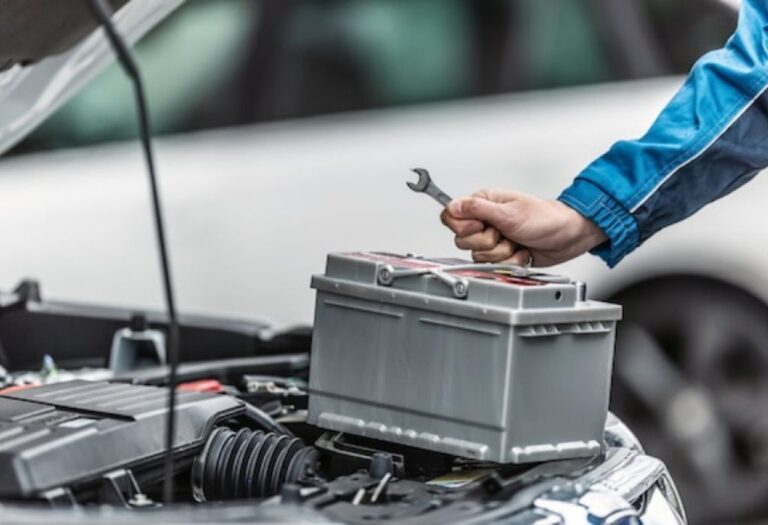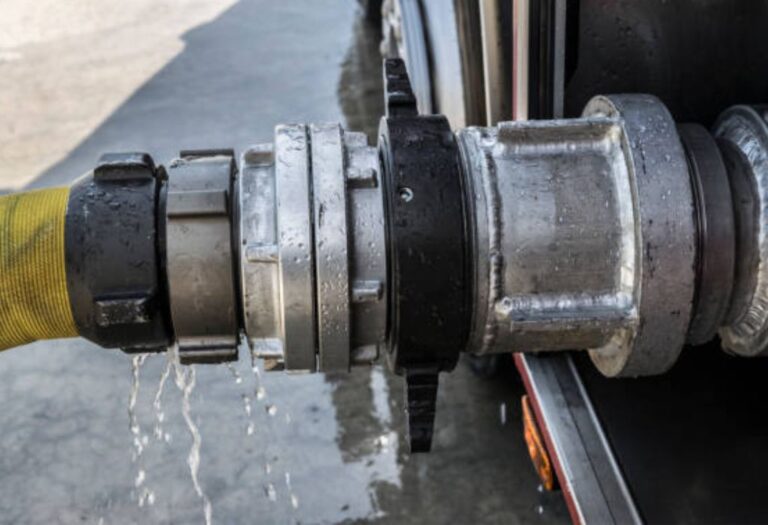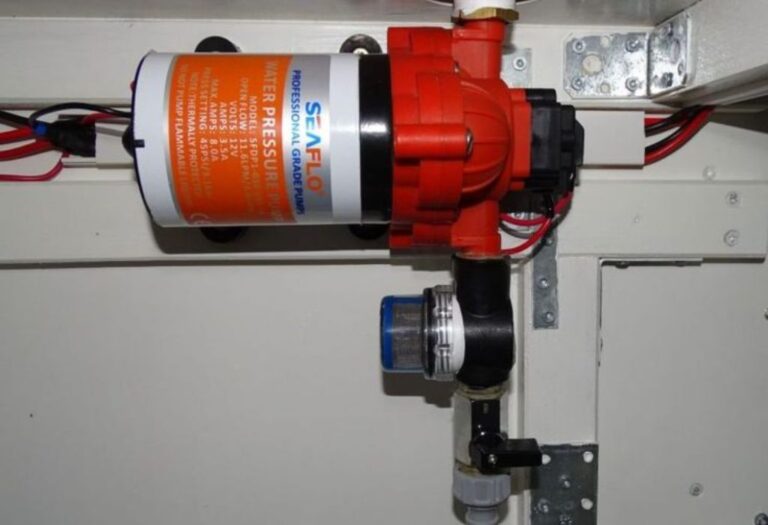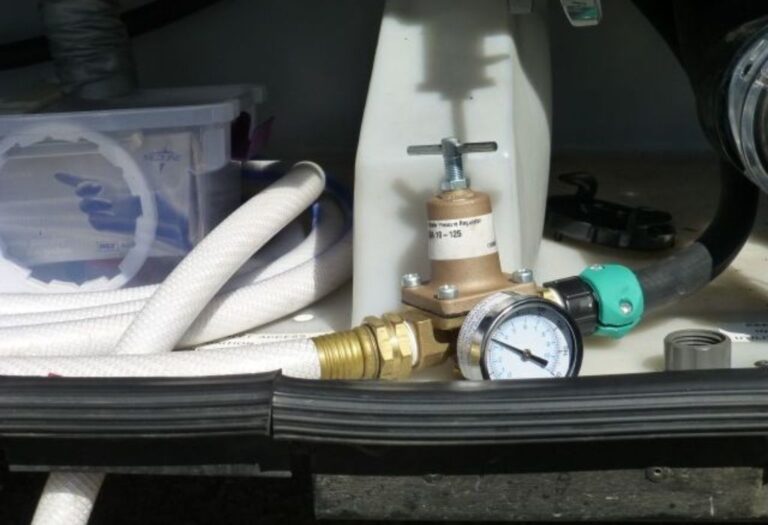How Much Water Pressure Can an RV Handle?
A weekend at a peaceful lakeside campground should be relaxing until a simple turn of a faucet turns into a disaster.
Within seconds, water starts leaking beneath the sink, and a small puddle spreads across the RV floor.
Many travelers face this exact moment after connecting to city water, unaware that excessive pressure is silently damaging their plumbing system.
Unlike residential homes, RVs are built with lightweight hoses, fittings, and flexible PEX lines.
These materials make the system efficient but also fragile under too much pressure. In fact, most RVs are designed to handle no more than 60 PSI, while some campgrounds deliver water at 90–120 PSI .
That difference can easily burst a hose, crack a faucet, or flood the floor within minutes.
According to the RV Industry Association (RVIA), the ideal range for RV plumbing systems is 40–55 PSI, balancing safety with comfortable water flow .
Without a regulator, however, you’re depending entirely on the campground’s water line — and that’s a gamble no traveler should take.
Knowing how much water pressure an RV can handle helps protect against costly repairs, conserve water, and maintain consistent pressure throughout your trip.
This guide breaks down safe PSI levels, the risks of unregulated water connections, and simple tools that prevent plumbing damage before it starts.
Before turning that faucet again, it’s worth learning how a few PSI could mean the difference between a comfortable weekend and a flooded RV floor.
Understanding RV Water Pressure Basics
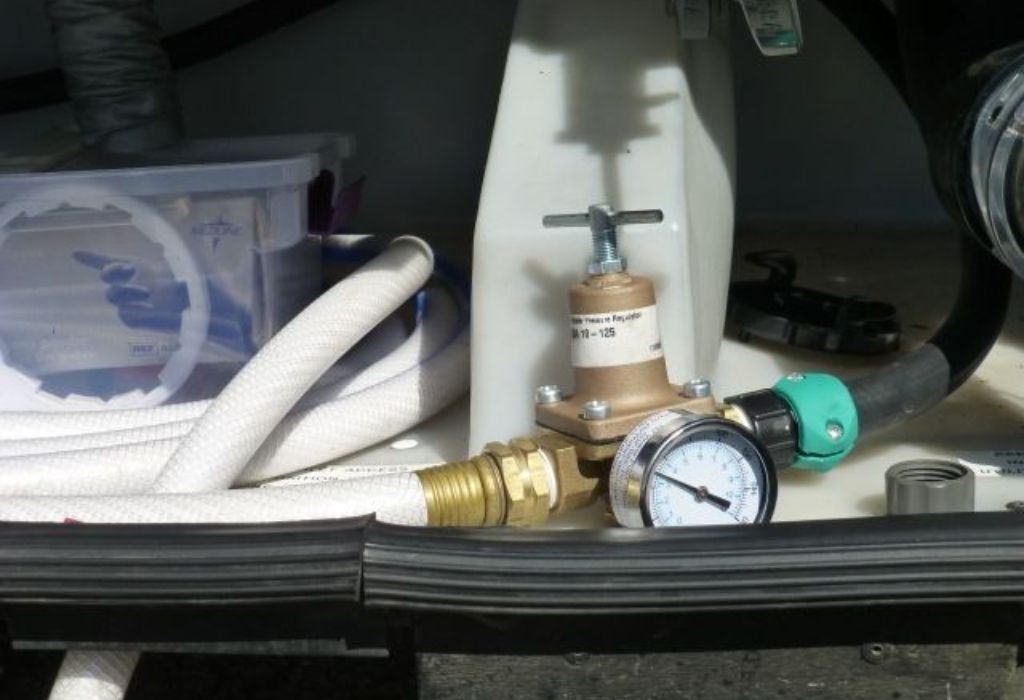
Water pressure determines how quickly and forcefully water flows through your RV’s plumbing system. It’s measured in PSI (pounds per square inch) — a number that can mean the difference between a smooth shower and a costly repair.
Most RV owners underestimate how sensitive their plumbing is compared to a home’s. While residential systems can often withstand up to 80 PSI, RV plumbing components are designed for far less.
Before learning how much water pressure an RV can handle, it’s important to understand how PSI works and why even a small change in force can impact the entire system.
What Is Water Pressure and Why It Matters
Water pressure pushes water through your pipes and determines the strength of flow from every faucet. The more pressure you apply, the harder water forces its way through connections and seals.
What does PSI stand for?
PSI means “pounds per square inch” — the amount of force applied to the inside of your RV plumbing system.
Why is water pressure important in an RV?
It controls how efficiently water flows through sinks, showers, and toilets without overloading the pipes.
Is higher PSI always better?
No. Excessive pressure can burst hoses or loosen seals, leading to leaks.
What is the ideal PSI range for comfort and safety?
Most RVs perform best between 40 and 55 PSI.
Can RV plumbing regulate itself automatically?
No, unless a regulator is installed, the system will receive full campground pressure.
How RV Plumbing Differs from Home Plumbing
Your home plumbing uses heavy-duty copper or PEX lines that easily tolerate 70–80 PSI. RV plumbing, on the other hand, is lighter and made for mobility, not high pressure.
Why can’t RV systems handle high pressure like homes?
RV lines and fittings are thinner and more flexible, which makes them prone to bursting under excess PSI.
What materials are RV plumbing lines made of?
Mostly PEX, vinyl, or lightweight plastic tubing rated for around 50–60 PSI.
What happens when pressure exceeds the limit?
Connections loosen, hoses expand, and small leaks start forming behind panels.
Do older RVs need extra protection?
Yes, aging seals and fittings are more likely to fail under even moderate pressure spikes.
Can modern RVs tolerate slightly higher PSI?
A few high-end models might handle up to 70 PSI, but long-term exposure still risks damage.
Why Water Pressure Fluctuates at Campgrounds
Water pressure at campgrounds isn’t stable. It depends on water demand, location, and infrastructure age.
Why is campground pressure inconsistent?
Shared water lines cause drops during peak usage and spikes when few RVs are connected.
Can city-supplied water exceed safe levels?
Yes, some city hookups reach over 100 PSI during low-demand hours.
How does altitude affect PSI?
Higher elevations slightly lower water pressure due to reduced gravity force.
Can you predict campground PSI before arrival?
Not accurately — testing it yourself with a gauge is the only reliable method.
Should you adjust your regulator often?
Yes, different campsites require fine-tuning for consistent flow and safety.
How Much Water Pressure Can an RV Handle Safely
Most RVs can safely handle 40–60 PSI, but experts recommend staying near 50 PSI for optimal flow and longevity. Exceeding 60 PSI risks leaks, especially in older or lightweight systems.
Manufacturer Recommendations
RV manufacturers specify maximum PSI ratings for plumbing components, which usually fall around 60 PSI. Always check your owner’s manual for confirmation.
What is the safe water pressure for an RV?
Between 40 and 55 PSI for most systems.
What’s the danger zone?
Anything above 60 PSI may cause leaks or failure.
Can a luxury RV handle more?
Some can manage up to 80 PSI, but regulation is still required.
Should you exceed 60 PSI?
No, staying under that level prevents long-term damage.
Can low PSI be harmful?
Only to comfort and water flow, not to the plumbing itself.
Real-World Pressure at Campgrounds
Campground PSI varies widely based on water source, elevation, and demand. Some municipal-supplied sites spike as high as 120 PSI.
How do you check campground pressure?
Attach a water pressure gauge to the spigot before connecting your hose.
Is high pressure rare?
No. It’s common in newer or high-demand RV parks.
What’s the lowest pressure you’ll encounter?
Some rural sites drop to 20–30 PSI during peak use.
Can regulators fix inconsistent pressure?
Yes, adjustable regulators stabilize fluctuations automatically.
Should you test every site?
Always. Each campground has unique conditions.
What Happens If Water Pressure Is Too High
High water pressure in an RV may seem harmless at first but can quietly weaken connections over time. A single high-pressure event can rupture hoses or fittings and flood interiors within minutes.
Common Damage from Overpressure
Even if leaks aren’t visible immediately, microscopic cracks can form inside PEX lines or fittings, causing slow water loss and eventual system failure.
What breaks first under too much pressure?
Hoses, faucets, and joints take the brunt of the force.
Can water heaters be affected?
Yes, internal seals and valves can rupture under excess PSI.
Does overpressure waste water?
Yes, higher flow rates use more water unnecessarily.
Can it affect toilets and showers?
Yes, valves and seals can leak or break.
Does insurance cover water damage from pressure?
Not always — many policies exclude preventable damage.
Warning Signs of Excessive Pressure
Overpressure symptoms often appear subtly before major leaks occur.
Can dripping faucets indicate trouble?
Yes, persistent drips may mean internal valve stress.
Are bulging hoses dangerous?
Yes, they indicate swelling from internal pressure.
Do loud pipes signal a problem?
Yes, banging or knocking sounds show water hammer effects.
Can high pressure cause air in lines?
Yes, it displaces trapped air and creates noisy bursts.
What should you do if you suspect overpressure?
Turn off the main valve immediately and install a regulator before reconnecting.
What Happens If Water Pressure Is Too Low

Low water pressure won’t damage your system but makes everyday tasks inconvenient. It also hints at clogs or worn-out components in the plumbing line.
Causes of Low Pressure
Low PSI can result from campground supply issues, clogged filters, or kinked hoses.
Why does pressure drop suddenly?
A blocked filter or kinked hose restricts flow.
Do long hoses reduce PSI?
Yes, friction loss increases with hose length.
Can altitude reduce water flow?
Slightly, as water pressure decreases at higher elevations.
Is low pressure common during peak hours?
Yes, shared supply lines lower overall PSI.
Can a regulator cause low flow?
Yes, if it’s clogged or set too low.
Effects of Low Pressure
While not dangerous, low pressure can make daily water use frustrating.
Does it affect water heaters?
Yes, insufficient flow prevents them from cycling properly.
Can it impact shower quality?
Absolutely — flow becomes weak or uneven.
Can filters be the cause?
Yes, dirty sediment filters significantly reduce pressure.
Can the RV pump fix low pressure?
Yes, turning on your onboard pump helps boost flow.
Should you bypass the regulator?
Never — it’s your plumbing’s safety device.
How to Measure and Maintain Safe RV Water Pressure
Knowing how much pressure enters your RV is the first step toward protection. Regular testing and the right tools prevent problems before they start.
Tools You’ll Need
Use a water pressure gauge or a regulator with a built-in gauge for consistent readings.
Where do you attach a gauge?
Directly to the water spigot or inline before your hose.
What’s a normal PSI reading?
Between 40 and 55 PSI is ideal.
Can digital gauges work?
Yes, they’re precise but more fragile than analog ones.
Should you test before connecting?
Always test campground pressure first.
How often should you check?
At every new campground or after long storage.
Using a Regulator
A regulator is the simplest, most effective protection against overpressure.
What does a regulator do?
It restricts incoming PSI to a safe level for RV plumbing.
Are adjustable regulators better?
Yes, they let you set the exact PSI your system needs.
What’s the most common preset regulator PSI?
Usually 45 PSI, suitable for most RVs.
Should you use a gauge with a regulator?
Yes, to monitor ongoing pressure accurately.
Do regulators wear out?
Yes, replace them every few years for consistent performance.
Choosing the Right Regulator for Your RV
There are several regulator types, each with pros and cons based on budget and RV type.
Fixed Regulators
Simple and inexpensive, these regulators are preset at a safe PSI, usually 40–45.
Who should use fixed regulators?
Casual campers who visit serviced campgrounds.
Can fixed regulators handle high flow?
Yes, but they lack adjustability.
Do they need maintenance?
Minimal — just occasional cleaning.
Are they accurate?
Reasonably, though not as precise as adjustable types.
How long do they last?
Typically 3–5 years.
Adjustable Regulators
These let you fine-tune PSI to match campground conditions and RV type.
Why choose adjustable regulators?
They offer full control for changing pressures.
What’s the ideal adjustable range?
30–80 PSI for flexibility.
Do they need calibration?
Yes, occasionally to maintain accuracy.
Should you buy brass or plastic?
Brass lasts longer and resists corrosion.
Do they cost more?
Yes, but they’re worth it for precision and safety.
Troubleshooting Pressure Issues
Pressure inconsistencies are common, but quick fixes can restore normal operation.
Low Flow Despite Normal PSI
If pressure readings are fine but flow remains weak, internal restrictions are likely.
Check filters first?
Yes, clogged filters are the top culprit.
Could it be the showerhead?
Yes, mineral buildup limits flow.
What about hose kinks?
Always inspect the full hose length.
Is regulator clogging common?
Yes, especially after long storage.
Should you flush the system?
Yes, periodically to clear buildup.
Pressure Fluctuation or Surging
Sudden surges can result from pump cycling or campground instability.
Why does PSI jump up and down?
Multiple RVs using the same line create fluctuations.
Can a faulty regulator cause this?
Yes, worn seals lose control.
Can an accumulator tank help?
Yes, it smooths out surges.
Does temperature affect water pressure?
Heat expands water, causing slight PSI increases.
How to fix persistent surges?
Replace the regulator or install a stabilizing tank.
Seasonal Maintenance and Long-Term Tips

Maintaining your RV’s water system ensures consistent pressure and longer plumbing life.
Before Winter Storage
Winterizing prevents frozen lines and burst hoses.
Should you drain all water?
Yes, fully empty lines before storage.
Do regulators need drying?
Yes, keep them moisture-free.
Can antifreeze affect pressure regulators?
Not directly, but avoid leaving any trapped liquid.
Check fittings before spring?
Always inspect for cracks or leaks.
Store gauges indoors?
Yes, cold can damage internal seals.
Routine Inspections
Regular maintenance keeps PSI stable year-round.
How often to replace hoses?
Every 5–7 years.
Gauge calibration needed?
Every 2–3 years for accuracy.
When to change regulators?
Every few seasons or if pressure fluctuates often.
Inspect fittings when?
Before every major trip.
Keep spare parts?
Yes, always carry a backup regulator and hose.
Conclusion
Most RVs can safely handle 40–60 PSI, with 50 PSI being the sweet spot for optimal performance. Anything beyond that risks damaging your plumbing, while lower pressure simply affects comfort.
By testing water pressure before every hookup and using a reliable adjustable regulator with a gauge, you can travel confidently without fear of leaks or bursts.
Water pressure management isn’t just about comfort — it’s about protecting your RV from hidden damage and unnecessary repair costs. The next time you pull into a campsite, take one minute to check PSI before connecting. That small habit ensures your RV stays safe, dry, and ready for every adventure ahead.
I’m David R. Coleman, the founder, lead writer, and lifelong tool enthusiast behind GarageToolPro.com. With years of experience in automotive repair, woodworking, and home DIY projects, I created this platform to share practical tips, detailed tool reviews, and step-by-step guides that help mechanics, hobbyists, and homeowners get the job done right the first time.

